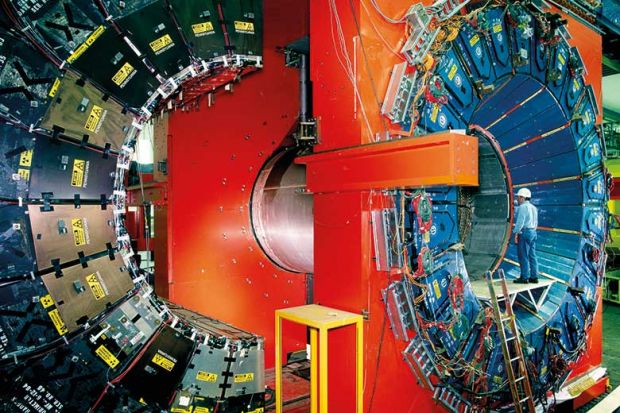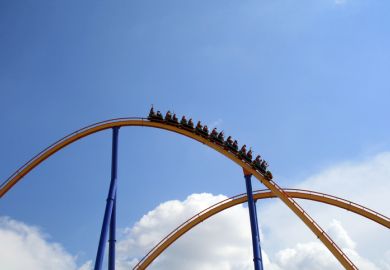In the late 1980s, the Wild West was a mere 40 miles (64km) outside Chicago. Or rather that’s where Fermilab, the scientific equivalent, was sited. Fermilab, home to the Tevatron particle collider, was the frontier of particle physics exploration of its day, and a magnet for scientists determined to beat back that frontier even further. In Anomaly!, Tommaso Dorigo describes these scientists and their search for discoveries as part of Tevatron’s Collider Detector at Fermilab (CDF). If you thought that science was a boring, Teflon-coated line of consensual progress, think again. There are more anomalies outlined in this book than science has a hope of explaining; more arguments, fights and unprovoked rudeness between physicists than you’d find in a playground; and more Mexican stand-offs than in any spaghetti western.
In frontier physics, there are no prizes for coming second; and when the collaborators are scientists all desperate to get there first, sparks can fly. Dorigo shows that in CDF there was not just science at stake but reputation, too. From the off, we’re given a sense of an experiment muscling its way into history with total commitment.
The big prize for the CDF collaboration was the discovery of a previously unseen fundamental particle called a top quark, the heaviest elementary particle ever observed. It’s the kind of accomplishment that makes physicists dream of a Nobel prize – assuming that they can sleep at all when there’s a chance that they might find it. Such discoveries are not everyday occurrences; it is fiendishly difficult to tease out a signal to the satisfaction of both your conscience and your colleagues. Dorigo’s description of the teams competing desperately to find the top quark is more than simple history of science. His account shows that anyone, however ambitious or antisocial, will work together if the prize is valuable enough, and that this combatively collaborative approach can achieve results better than can any individual physicist.
The top quark, it turns out, wasn’t CDF’s only discovery. There were also the anomalies of the book’s title. Spurred on by competition with their sister Tevatron experiment, D0, as well as experiments in Europe and theorists pushing Nobel-worthy alternative theories such as supersymmetry, CDF scientists uncovered unexplained features as they scrutinised their data. We learn of the infamous superjets, whose interpretation almost split the collaboration, the “preon” candidates that were either new fundamental particles or a shortcoming in predictions, and the supersymmetry signal that turned out not to be. What distinguishes an anomaly from a real discovery is the significance of the supporting evidence. Dorigo treats us to a crash course in Occam’s razor, hypothesis-testing and the sort of statistical questions that particle physicists like to torment themselves with.
The superjets affair turned out to be one of CDF’s biggest and most interesting headaches. A tiny subset of data relating to high-energy streams of particles, superjets didn’t match any known physics process of the time. CDF scientists’ interpretations ranged from the prosaic (badly understood analysis techniques) to the madly exciting (exotic new physics processes). One CDF scientist, Paolo Giromini, even claimed that his interpretation of the data implied that CDF’s most important published discovery was too optimistic – something that did not go down well with his colleagues. Not someone given to self-doubt or excessive diplomacy, as Dorigo recounts, Giromini didn’t stop there. After a thorough analysis of the anomalous data and interpretation of their “weird features” as new physics, he demanded special treatment: a fast track to publication to avoid normal peer review and getting “stuck in the mud” by the collaborators he’d previously crossed.
Dorigo’s sympathies lie firmly with Giromini, whom you imagine striding the CDF corridors in a poncho, teeth clenching a cigar and scowling in true Clint Eastwood fashion. CDF scientists (including Dorigo) were directed to put their own work aside and evaluate the significance and correctness of Giromini’s findings. The work passed all tests, but its interpretation split the review committee. In the meantime, Giromini’s group “kept adding gasoline to an already vigorous fire” by claiming a potential sign of supersymmetry elsewhere in the data and asking for a fast-track procedure to publish that, too. By the end of this book, consensus is reached. The collaborating researchers sign a paper detailing the facts about the superjet data, and it is left to Giromini (and Dorigo, and a handful of others) to sign a paper interpreting what those data might be.
These episodes are entertaining, but they also make a serious and interesting point that is rarely explored in popular science books. Establishing phenomena beyond reasonable doubt, when you don’t understand them, is hard. And this is what frontier science is about: a meticulous mapping of territory rather than a diehard gallop through unknown country – even when Clint Eastwood keeps racing off into the distance enticing you to chase him.
What makes Anomaly! unique is the sense of what research is like within a collaboration determined to make history. You’ll encounter continent-sized egos, self-styled “conservativeness jihadists” who try to block unfamiliar analysis techniques with accusations of “monkeys dealing with heavy machinery”, and scientists who delight in teasing and obfuscating. These sound like the sorts of dysfunctional colleagues who would fill you with Blair Witch Project-level terror even if you had the Atlantic Ocean and a good 20 years separating you. But against the odds, CDF’s research team achieved an extremely careful and effective collaboration, even if this book suggests that it was sometimes on the verge of shoot-outs in the corral.
For most of the period covered by this book, Dorigo was at CDF working on his PhD, and he knows his protagonists well. The author of a popular, very readable blog, he serves up descriptions that are lively and colourful – so colourful, in fact, that former colleagues must be sneaking anxiously into bookshops to check whether their names appear in the index. You’ll be entertained by his descriptive and sometimes outrageous storytelling – unless you’re a particle physicist, in which case you’ll be tempted to look at some of this through your fingers. But whatever your discipline, you’ll be tempted to memorise the worst moments to regale your friends with down the pub, such as the tale of the hapless Italian postdocs who inadvertently set fire to their radioactive source and incurred the considerable wrath of the Fermilab radiation safety team, which is the stuff of particle physics legend.
Despite its entertainment value, however, Anomaly! isn’t a perfect survey of its subject. If you haven’t come across particle physics before, some of the science and the jargon might be difficult to follow, despite the quick introduction provided in the opening chapters. You’ll find better general descriptions elsewhere. Some of the earlier stories don’t follow an apparent narrative and appear to have been thrown in to increase the gossip count. The narrative itself is partial. You’re treated to history through Dorigo’s eyes and personal biases; like any good particle physicist, he may not judge – but he certainly has opinions.
There have been other accounts of discovery in particle physics experiments, notably Nobel Dreams: Power, Deceit, and the Ultimate Experiment, Gary Taubes’ study of ruthless ambition, and the many recent books telling the Higgs boson story. But none has captured the boom-and-bust cycle of collaborative frontier science quite so well and quite so entertainingly as Dorigo. His lively tour of the false discoveries and crushed ambitions, the outrageous hope, hard work and intense focus is a guilty pleasure in the very best sense.
Tara Shears is professor of physics, University of Liverpool.
Anomaly! Collider Physics and the Quest for New Phenomena at Fermilab
By Tommaso Dorigo
World Scientific, 304pp, £91.00 and £40.00
ISBN 9781786341105 and 1112
Published 24 November 2016
Author profile - Tommaso Dorigo: "Enmity, mockery, secret banning, career hindrance. You name it, I’ve had it"
POSTSCRIPT:
Print headline: Everyone wants to be top dog in the hunt for the top quark
Register to continue
Why register?
- Registration is free and only takes a moment
- Once registered, you can read 3 articles a month
- Sign up for our newsletter
Subscribe
Or subscribe for unlimited access to:
- Unlimited access to news, views, insights & reviews
- Digital editions
- Digital access to THE’s university and college rankings analysis
Already registered or a current subscriber? Login






